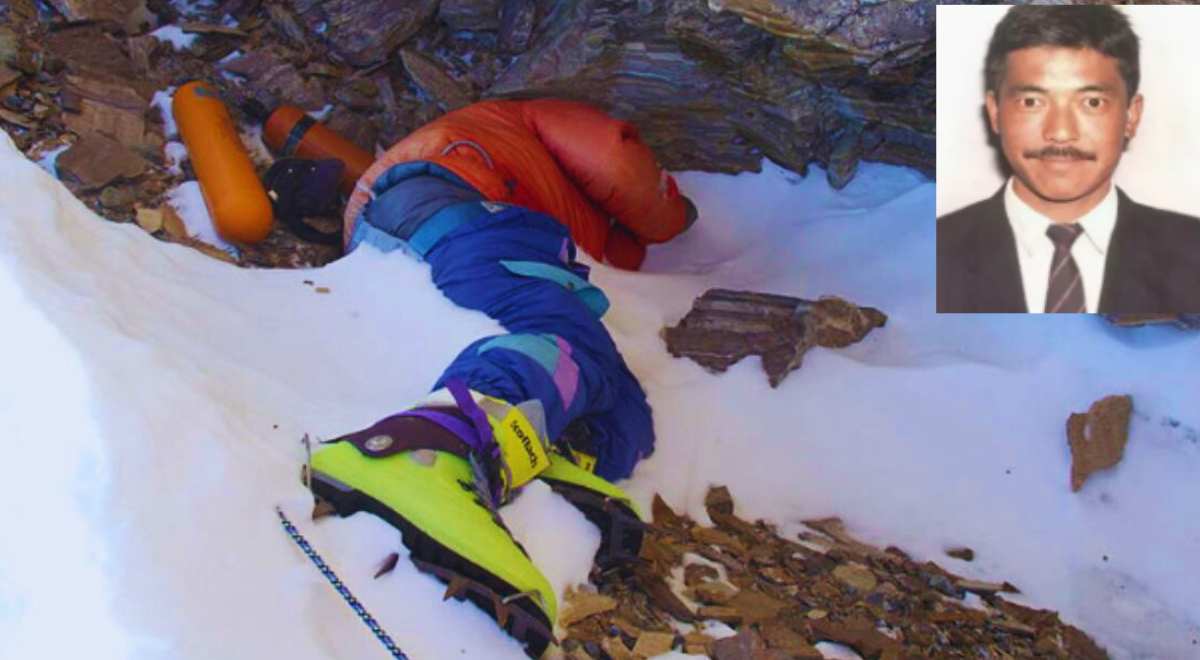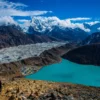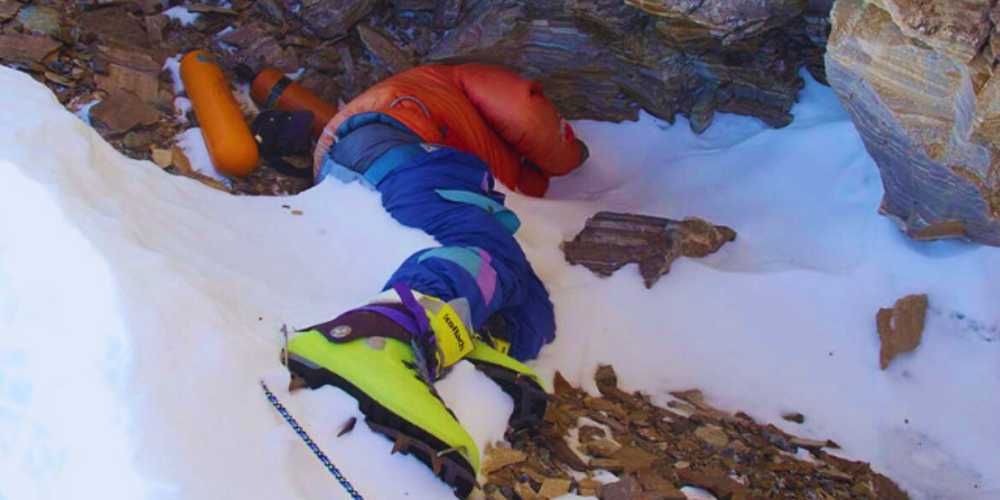17 Days
Moderate

Mount Everest is the tallest mountain in the world with a height of 8,848m and it is a big challenge for many people who like to climb mountains. When climbers decide to conquer Mount Everest, they are not just facing physical difficulties, but also mental and emotional challenges too. The weather on the mountain is extreme, the terrain is dangerous, and there is always the risk of altitude sickness. However, reaching the summit is a dream come true for many climbers, showing that they can overcome nature’s toughest obstacles.“Green Boots” is the nickname for a climber’s body in the Death Zone above 8,000 meters on Mount Everest, a place where survival is extremely difficult. This spot is a grim landmark on the way to Everest’s summit.
The story of Green Boots is about Tsewang Paljor, a 28-year-old climber from Shakti village in India. In 1996, he joined an expedition to climb Everest, but a severe storm took his life and the lives of others. This tragedy highlights both the determination of climbers and the dangers of Everest.
Tsewang Paljor’s story symbolizes courage and ambition, highlighting the bravery needed to face this dangerous climb. When climbers pass by “Green Boots,” they remember the risks of the journey and Paljor’s lasting impact, which continues to inspire the mountaineering community.

17 Days
Moderate
Green Boots is a nickname given to an unidentified mountaineer whose body became a landmark for other climbers on the northeast route of Mount Everest. The nickname comes from the bright green climbing boots he was wearing when he died.
It’s widely believed that Green Boots was Tsewang Paljor, an Indian climber who was part of the ill-fated 1996 Indo-Tibetan Border Police expedition. Tragically, Paljor and his team were caught in a severe storm while descending the mountain, and he never made it back.
For years, Green Boots’ presence on Everest is a grim reminder of the risks climbers take, as he remained on the mountain due to body retrieval difficulties. His story is frequently mentioned in conversations about the challenges of recovering bodies on Everest and the tough nature of high-altitude climbing.

Tsewang Paljor was born on April 10, 1968, in a small village named Shakti, located in India. From a young age, Paljor’s heart was captivated by the majestic allure of mountains. It was as though the peaks called out to him, igniting a passion that would shape his life. This deep-seated love led him to dream of one day standing atop the world’s highest summit—Mount Everest.
His strong dedication to mountaineering was more than just a hobby; it was a deep commitment that worked well with his job. As a member of the Indo-Tibetan Border Police (ITBP), Paljor found a way to do what he loved and fulfill his duty at the same time. The ITBP is responsible for protecting the borders between India and China in harsh environments, giving Paljor valuable training and experience in climbing at high altitudes. This training was crucial for his journey to Mount Everest, teaching him resilience and courage that would later be remembered as his legacy.
The 1996 Everest expedition was marked by ambition and hope. Led by expedition leader Mohinder Singh, Paljor and his team, composed of six experienced climbers from the ITBP, embarked on a journey filled with promise and peril. The team aimed to take on the eastern plains of Everest, determined to make their nation proud.
Unfortunately, not having skilled Sherpas on the team was a major problem. Sherpas are the local people who know Mount Everest very well. Paljor’s team had a tough time without their important help, especially when the weather changed.
A sad day unfolded when Paljor, Tsewang Samanla, and Dorje Morup encountered a fierce snowstorm at the summit. The storm made it difficult to see and the cold was extreme, resulting in their deaths. Although they tried to communicate their success at their summit via radio, they couldn’t withstand the harsh conditions. Sadly, their bodies were not recovered in time and vanished in the storm, never to return to their camp.
Tsewang Paljor’s life was marked by courage and resolve, yet also touched by tragedy. Upon his passing, green boots were discovered near him at a high altitude.
The ownership of these boots, whether they belonged to him or Morup, remains uncertain. However, the prevailing belief is that they were his, and he is now commemorated as the climber in the “Green Boots,” a symbol of the mountain’s strength.
From a mere nickname for an unidentified body, Green Boots has become a chilling landmark for those who dare to climb Everest. This story of the tragic figure serves as a reminder of the harsh conditions and emotional turmoil one may encounter when facing the formidable challenge of the mountain.
For many climbers passing by Green Boots, the figure serves as a strong reminder of the dangers of extreme mountain climbing. It makes them reflect on the delicate balance between passion and risk. The cave where Green Boots is found is not just a stopping point, but also a sad symbol of the climbers who lost their lives chasing their dreams on the tallest peaks.
Green Boots is now a sign of warning and honor to climbers since his body was not brought back and his identity remains uncertain. This shows us the importance of being careful and respecting the dangers of climbing difficult mountains.
Reflecting on Green Boots’ story reminds us of the person who dared to pursue his dreams with bravery and continues to be an inspiration to climbers globally. His legacy lives on in the snowy terrain of Everest and in the story of human strength and determination in the face of seemingly impossible challenges.
Green Boots, believed to be the Indian climber Tsewang Paljor, has become a well-known figure in the mountaineering world. His body was found under a rocky cave called the “Green Boots Cave” at 27,890 feet on Everest’s Northeast Ridge. For climbers attempting to conquer the world’s highest peak from the North, Green Boots was a solemn reminder of the challenges of the mountain.
In 2014, some climbers reported that Green Boots could no longer be seen at his regular location. This resulted in discussions and speculations about whether the body had been relocated or respectfully buried. These efforts are in line with ongoing attempts to clean up Mount Everest and honor those who have lost their lives on its treacherous slopes. Numerous campaigns have been launched by governmental and non-governmental organizations over time to recover bodies and reduce the environmental impact of climbing expeditions.
Furthermore, Back in 2017, reports said the body was there, just covered by rocks, maybe as a way of showing respect to other climbers. It’s really tough to bring bodies down from high places because it’s dangerous and hard to do, and it costs a lot of money. Some families can’t bring their loved ones home, but these cleanup projects help honor and remember those who passed away.
Climbers on Mount Everest use Green Boots as a resting spot. It is not shown on a map but it is remembered by those who have been there.
Green Boots also symbolized the human cost of pursuing the summit. Seeing him brought climbers face-to-face with the reality of Everest’s “Death Zone“—a region above 8,000 meters where life is vulnerable, and survival is uncertain. In paying respects to Green Boots, climbers are reminded of their mortality and the honor of those who have attempted the audacious climb.
The debate over his identity increased his popularity among climbers. Whether he was truly Tsewang Paljor or not, Green Boots represents the sacrifice many make to reach great heights. His legacy reminds climbers to treasure every moment of their lives, not just their accomplishments.
The act of covering or moving bodies from these well-known paths is often done out of great respect and understanding. Stories like Green Boots and others highlight the importance of safety, preparation, and admiration for the greatness and risks of the world’s most challenging mountain.

On the trail to Everest Base Camp, many trekkers find inspiration not just in the towering peaks and breathtaking landscapes, but also in the stories etched into the mountain’s legacy—like that of “Green Boots.” Although his final journey ended near the summit of Everest, his story serves as a powerful reminder of the courage and determination it takes to venture into these high altitudes. For those trekking to Everest Base Camp or other Treks in the Himalayas, Green Boots symbolizes both the immense challenge and the deep respect this mountain commands. His silent presence in Everest’s history continues to inspire trekkers to trek with humility, preparation, and a renewed appreciation for the strength of the human spirit in the face of nature’s extremes.
Climbers who walk past Green Boots, come across a tough challenge in mountain climbing. The problem is not knowing who Green Boots is, but not being able to move it. Mount Everest is a difficult place with many obstacles that make it almost impossible to retrieve bodies safely and without spending too much money and energy.
In other words, the Green Boots stays undisturbed on Everest because the mountain requires a deep respect for the forces that control life and death.
Climbing to the top of the world is not just a physical challenge; it’s also a hazardous journey into what is known as the “Death Zone.” This term is used to describe the areas on Mount Everest that are above 8,000 meters (26,247 feet), where there is not enough oxygen to sustain human life for long periods of time.
The Death Zone is a term used for altitudes above 8,000m where oxygen is very limited and humans cannot acclimatize and breathe properly. For climbers, this means exposure to extreme lack of oxygen, leading to problems with thinking, losing consciousness, and even death.
Once a person reaches this high altitude, their body starts to use up its own resources in a desperate attempt to survive, making it very challenging just to stay alive, let alone climb.
The Death Zone is a term for altitudes above 8,000m with limited oxygen supply. Climbers may face challenges due to lack of oxygen, such as difficulty thinking and the risk of losing consciousness or death. Here are some Death Zones in Mount Everest:
1. South Col (7,906 m): Situated at an elevation of 7,906 meters, the South Col on Mount Everest is known as a dangerous Death Zone. Climbers who reach this height face extreme oxygen deprivation, leading to potential health risks such as altitude sickness, cerebral edema, and fatal consequences.
2. Geneva Spur (7,906 m): At an elevation of 7,906 meters (25,160 feet), the Geneva Spur is a treacherous Death Zone on Everest. Climbers encounter high winds, icy conditions, and low oxygen levels, making it a dangerous area to navigate.
3. The Balcony (8,440 m): The Balcony on Mount Everest sits at an elevation of around 8,440 meters (27,690 feet) and is notorious for being a Death Zone. Climbers who reach this point often experience severe fatigue, lack of oxygen, and challenges with focus and coordination, putting them at a high risk of altitude-related illnesses and even death.
4. The Triangle Face (8,000 m): The Triangle Face, situated at an altitude of 8,000 meters, poses a challenging obstacle for climbers on Everest. With harsh weather, limited visibility, and extreme exhaustion, even the most experienced mountaineers find it difficult to stay safe in this area.
5. The Hillary Step (8,790 m): Situated at an elevation of 8,790 meters (28,839 feet), the Hillary Step is a final Death Zone on the way to the summit of Mount Everest. Climbers must navigate this vertical rock face with minimal oxygen supply, facing extreme physical and mental challenges as they push their limits to reach the peak, risking severe altitude sickness and even death.
These places create a battlefield where mountain climbers test their skills against the weather. The Death Zone has risky conditions like low oxygen, cold weather, strong winds, and physical effort. This can lead to “summit fever,” where climbers take dangerous risks.
These places create a battlefield where mountain climbers test their skills against the weather. The Death Zone has risky conditions like low oxygen, cold weather, strong winds, and physical effort. This can lead to “summit fever,” where climbers take dangerous risks.
Green Boots’ story serves as a grim reminder of the potential tragedies that can occur during an Everest climb. The mountain’s beauty is overshadowed by its deadly dangers above 8,000 meters. The Death Zone, where Green Boots’ body lies, is known for its harsh climate and history of irreversible accidents. The freezing temperatures and low oxygen levels in this area create a hazardous environment. Venturing into this region without proper preparation can lead to dire consequences, as Paljor and his team discovered.
Climbing down can be as dangerous as climbing up. Paljor and his companions were stuck in a storm after a tiring climb, showing the importance of timing and weather knowledge. Decision-making can be fatal. Climbers need to be cautious and know their limits. Paljor’s story reveals the risks of Everest. Despite challenges, climbers are attracted to conquering the peak.
Ultimately, the story of Green Boots shows how tough the mountain is. It reminds climbers and others to be cautious and to pay respect to the power of nature.
The story of Green Boots offers essential lessons for any aspiring mountaineer, and indeed, for anyone with ambitious dreams. Here are some of the key takeaways from this legacy:
The tragic legacy that remains continues to inspire and warn those who strive to achieve greatness in the world. Let it be a lesson that as we follow our passions, It is crucial to approach our goals with careful consideration and a humble attitude, acknowledging the value of balance in our pursuits.
The story of Green Boots is about a climber who tragically lost his life on Mount Everest and became a famous landmark on the mountain due to his green boots being visible to other climbers. He is believed to be Tsewang Paljor, an Indian climber who died in the 1996 Everest disaster. His story serves as a reminder of the dangers of climbing the world’s highest peak.
Respecting nature is essential when climbing Everest because the mountain’s unpredictable nature can be extremely dangerous. Climbers must be aware of the power and unpredictability of nature to ensure their safety. It is crucial to know when it is safe to continue the journey and when it is best to turn back to prevent tragedy.
The tragedy on Everest emphasizes the need for excellent teamwork and communication among climbers. Listening to expedition leaders and their warnings is crucial, as poor decisions can have devastating consequences. Effective communication can save lives and ensure a successful climb.
Climbers on Everest display tremendous courage and resilience when encountering danger and adversity. Their determination and strong will to succeed in reaching the summit despite the risks involved demonstrate their bravery. The tragedy on Everest emphasizes the bravery and determination needed to conquer such a challenging feat.
The story of Green Boots serves as both an inspiration and a warning to climbers on Everest. It inspires climbers to demonstrate courage and resilience in pursuing their goals, but it also warns them of the dangers and risks involved in climbing the world’s highest peak. It is a reminder to approach their goals with caution and humility to ensure their safety.
Climbers can learn the importance of balance in pursuing their passions from the tragic legacy of Green Boots. While it is essential to demonstrate courage and determination in achieving one’s goals, it is also crucial to approach them with careful consideration and humility. Balancing ambition with caution can help prevent tragedy and ensure a successful climb.
Climbers can prepare themselves physically and mentally for the challenge of Everest by undergoing rigorous training and conditioning. Physical fitness, endurance, and strength are essential for withstanding the harsh conditions and demands on Mount Everest.